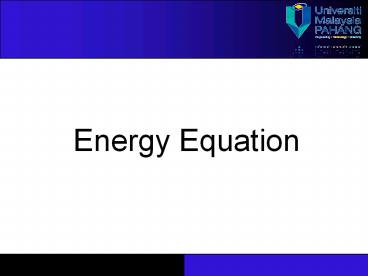ME33: Fluid Flow Lecture 1: Information and Introduction - PowerPoint PPT Presentation
1 / 21
Title:
ME33: Fluid Flow Lecture 1: Information and Introduction
Description:
Energy Equation Mechanical Energy? Forms of energy that can be converted to MECHANICAL WORK completely and directly by mechanical device(s) Kinetic energy (KE ... – PowerPoint PPT presentation
Number of Views:172
Avg rating:3.0/5.0
Title: ME33: Fluid Flow Lecture 1: Information and Introduction
1
Energy Equation
2
Mechanical Energy?
Forms of energy that can be converted to
MECHANICAL WORK completely and directly by
mechanical device(s)
Kinetic energy (KE) Potential energy (PE) are
forms of Mechanical energy (emech)
Thermal energy is not in the form of emech
3
Mechanical Energy? (Contd.)
Pressure can be associated with emech
P P/A N/m2 (N.m)/m3 J/m3
Its energy per unit volume!
Systems used to transport fluid may exerted
or extracted energy
4
Flow Work
Its the work effect produced due to pressure
acting over the distance
Stated in the amount of per unit mass (P/?)
Convenient to be expressed in fluid properties
terms as part of the fluid energy
Its called as FLOW ENERGY
5
Flow Work Flow Energy
For a flowing fluid, emech can be
written emech eflow KE PE (P/?)
(V2/2) (gz)
Changes of emech for a flowing fluid turns to
6
Flow Work Flow Energy (Contd.)
If emech gt 0 work is supplied to the fluid
If emech lt 0 work is extracted from the fluid
If emech 0 flow properties constant
Consider
(Cengel Cimbala, 2006)
7
Flow Work Flow Energy (Contd.)
From previous Figure also
Work generated per unit mass is same for top and
bottom generation i.e. emech top emech bottom
8
Energy Transfer and Efficiency
emech is transferred by rotating devices such as
pump and turbine Pump Transfer emech from
shaft to fluid Turbine Transfer emech from
fluid to shaft
Efficiency of emech conversion is ?mech
9
Mechanical Efficiency
Mechanical Efficiency is defined as
Where Emech, out Emech, in Emech, loss
10
Pump Turbine Efficiency
In fluid system, attention is given to increase
the pressure, velocity and elevation
This is done by supplying mechanical energy to
the fluid by pump of fan
Also, by reversing the process to reduce the
pressure, velocity, and elevation of the fluid
This is done by extracting mechanical energy from
the fluid by turbine
11
Pump Turbine Efficiency (Contd.)
Pump efficiency is defined as
Where
12
Pump Turbine Efficiency (Contd.)
While turbine efficiency is defined as
Where
13
Motor Generator Efficiency
Should not be confused with ?mech
Motor Efficiency
Generator Efficiency
14
Motor Generator Efficiency (Contd.)
?pump
?motor
Flowing Fluid
Motor (Pump)
Electrical Power
?turbine
?generator
Flowing Fluid
Electrical Power
Generator (Turbine)
15
Combined Efficiency
Pump-Motor System
Ratio of the increase in the mechanical energy of
the fluid to the electrical power consumption of
the motor
Turbine-Generator System
Ratio of the decrease in the mechanical energy of
the fluid to the electrical power generation of
the generator
16
Combined Efficiency (Contd.)
Mathematically
For pump-motor
For turbine-generator
17
Energy Simplification
Simplification in term of emech can be written as
emech in emech out ?emech system emech loss
For steady operation, energy balance turns to be
emech in emech out emech loss
Thats steady flow analysis!
18
Examples Tutorials
Consider a river flowing toward a lake at an
average velocity of 3 m/s at a rate of 500 m3/s
at a location 90 m above the lake surface.
Determine the total mechanical energy of the
river water per unit mass and the power
generation potential of the entire river at that
location
19
Examples Tutorials (Contd.)
Electric power is to be generated by installing a
hydraulic turbine-generator at a site 70 m below
the free surface of a large water reservoir that
can supply water at a rate of 1500 kg/s steadily.
If the mechanical power output of the turbine is
800 kW and the electric power generation is 750
kW, determine the turbine efficiency and the
combine turbine-generator efficiency of this
plant. Neglect losses in the pipes
20
Examples Tutorials (Contd.)
At a certain location, wind is blowing steadily
at 12 m/s. Determine the mechanical energy of air
per unit mass and the power generation potential
of a wind turbine with a 50 m diameter blades at
that location. Also determine the actual electric
power generation assuming an overall efficiency
of 30 percent. Take air density to be 1.25 kg/m3
21
- Next Lecture?
Bernoullis Equation































